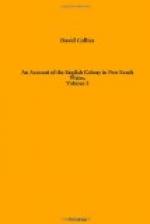At half past two a small island opened off from a low rocky point, behind which there was a small river running into the SW; but breakers seemed to extend mostly across the entrance. If there was any passage, it would be found on the south side of the island.
At half past three, a peaked hill, standing four or five miles inland, and more conspicuous than usual, bore true East. Before five, the vessel stood in for what appeared to be an opening, and about dusk was in the entrance to a wide shoal bay; soon after which she anchored in two and a half fathoms, on a hard sandy bottom.
The objects in view that induced Mr. Flinders to enter this bay were, that he might have daylight to run along the remaining part of the coast, which had been passed by Captain Cook in the night, and to ascertain a place of safety to run for, should the wind come dead on the coast on his return. The leak in the sloop was also a material part of the inducement; for should the place turn out to be of consequence enough to be worth expending a few days in its examination, and a convenient place offer itself for laying her on shore, he intended in the interval to get it stopped.
On examining this bay in his boat, he found it to be very shallow; the north point of the entrance into it was only a projecting spot of sandy ground. Having returned to the sloop about noon, he landed on the south head for the purpose of observing for the latitude. The sun being more than half an hour distant from the meridian gave him time to examine three huts which stood at a little distance. They were of a circular form, and about eight feet in diameter. The frame was composed of the stronger tendrils of the vine, crossing each other in all directions, and bound together by strong wiry grass at the principal intersections. The covering was of bark of a soft texture, resembling the bark of what is called the Tea-tree at Port Jackson, and so compactly laid on as to keep out the wind and rain. The entrance was by a small avenue projecting from the periphery of the circle, not leading directly into the hut, but turning sufficiently to prevent the rain from beating in.* The height of the under part of the roof is about four and a half, or five feet, and those that were




